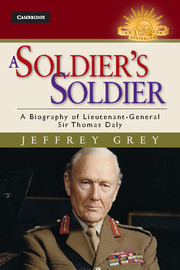Book contents
- Frontmatter
- Contents
- Illustrations
- Maps
- Tables and diagrams
- Acknowledgements
- Abbreviations
- Chapter 1 Regimental soldiering
- Chapter 2 Balikpapan, 1945
- Chapter 3 ‘He could fill any appointment with distinction’
- Chapter 4 The challenges of senior rank
- Chapter 5 Chief of the General Staff
- Chapter 6 Daly, the army and the war in Vietnam, 1966–71
- Chapter 7 The civic action crisis, 1971
- Chapter 8 Epilogue
- Notes
- Sources and Bibliography
- Index
Chapter 3 - ‘He could fill any appointment with distinction’
Published online by Cambridge University Press: 05 February 2014
- Frontmatter
- Contents
- Illustrations
- Maps
- Tables and diagrams
- Acknowledgements
- Abbreviations
- Chapter 1 Regimental soldiering
- Chapter 2 Balikpapan, 1945
- Chapter 3 ‘He could fill any appointment with distinction’
- Chapter 4 The challenges of senior rank
- Chapter 5 Chief of the General Staff
- Chapter 6 Daly, the army and the war in Vietnam, 1966–71
- Chapter 7 The civic action crisis, 1971
- Chapter 8 Epilogue
- Notes
- Sources and Bibliography
- Index
Summary
Australia emerged from the Second World War on the winning side, and in far better physical and economic shape than most of the victorious combatant nations other than the United States. Like the other dominions of the British Empire, Australia had avoided invasion and occupation with their attendant destruction, division and trauma (although, unlike Canada, New Zealand or South Africa, Australian territory had been attacked sporadically by the Japanese in the course of 1942–43). As a major supplier of US forces in the South-West Pacific Area, moreover, Australia emerged from the war as one of the few net creditor nations under the US-inspired Lend-Lease scheme. The suspension of the scheme within weeks of the end of the war placed the battered British economy under still greater stress but had little effect on Australia's.
Australia had been on the victorious side in 1918 as well, but having won the war could arguably be said, in common with most of the world's democracies, to have lost the peace during the interwar years. The ‘war to end wars’ had done nothing of the sort, and the economic depressions of the early 1920s and throughout the 1930s had led some to question the value of the sacrifices of the Great War generation, and had contributed seemingly little to the creation of a ‘land fit for heroes’. The political and strategic folly of the interwar years had been replicated in Australia as well: the general officers’ conference of 1921 had identified the most likely direct threat to Australia as being posed by Japan and had made recommendations for force structure and capabilities with which to meet it. Not surprisingly, so soon after the end of the Great War their report was ignored and, equally predictably, the conclusions of the Washington Treaty on Naval Armaments Limitations in 1922 had seen the small Royal Australian Navy further reduced in size and effectiveness. In 1945, however, the wisdom of massive postwar reductions in the armed forces in a context of emerging Cold War tensions between east and west was less than strikingly apparent – at least to some – and within the senior ranks of the Australian Army there was a strong belief that the mistakes of the interwar period should not be repeated now, nor the costs of such reductions visited upon a new generation of Australians whether in or out of uniform.
- Type
- Chapter
- Information
- A Soldier's SoldierA Biography of Lieutenant General Sir Thomas Daly, pp. 58 - 89Publisher: Cambridge University PressPrint publication year: 2012



